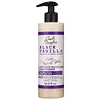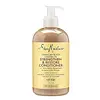What's inside
What's inside
 Key Ingredients
Key Ingredients

 Benefits
Benefits

 Concerns
Concerns

 Ingredients Side-by-side
Ingredients Side-by-side

Water
Skin ConditioningCetearyl Alcohol
EmollientGlycerin
HumectantBehentrimonium Methosulfate
Dimethicone
EmollientStearamidopropyl Dimethylamine
EmulsifyingParfum
MaskingPolysorbate 60
EmulsifyingAmodimethicone
Divinyldimethicone/Dimethicone Copolymer
Guar Hydroxypropyltrimonium Chloride
Skin ConditioningPhenoxyethanol
PreservativeDicetyldimonium Chloride
EmulsifyingCaprylyl Glycol
EmollientPolyquaternium-37
Citric Acid
BufferingCetrimonium Chloride
AntimicrobialDicaprylyl Carbonate
EmollientBenzyl Salicylate
PerfumingCoumarin
PerfumingPotassium Sorbate
PreservativeVp/Dmapa Acrylates Copolymer
Butyrospermum Parkii Butter
Skin ConditioningIsopropyl Alcohol
SolventPolyquaternium-7
Trideceth-15
EmulsifyingTrideceth-3
EmulsifyingHexylene Glycol
EmulsifyingBenzyl Alcohol
PerfumingPanthenol
Skin ConditioningTetrasodium Glutamate Diacetate
Alcohol Denat.
AntimicrobialC12-13 Pareth-23
CleansingC12-13 Pareth-3
EmulsifyingPolyurethane-14
Lauryl Glucoside
CleansingTocopherol
AntioxidantAmp-Acrylates Copolymer
Fumaric Acid
BufferingSodium Benzoate
MaskingRosa Canina Flower Extract
AstringentLavandula Angustifolia Flower Extract
CleansingUrtica Dioica Leaf Extract
Skin ConditioningRosmarinus Officinalis Leaf Extract
AntimicrobialTocopheryl Acetate
AntioxidantAscorbic Acid
AntioxidantCalendula Officinalis Flower Extract
MaskingMelilotus Officinalis Extract
AstringentSalvia Officinalis Extract
AntimicrobialBenzalkonium Chloride
AntimicrobialTrisodium Hedta
Vanilla Planifolia Fruit Extract
Skin ConditioningPEG-45m
HumectantBHT
AntioxidantWater, Cetearyl Alcohol, Glycerin, Behentrimonium Methosulfate, Dimethicone, Stearamidopropyl Dimethylamine, Parfum, Polysorbate 60, Amodimethicone, Divinyldimethicone/Dimethicone Copolymer, Guar Hydroxypropyltrimonium Chloride, Phenoxyethanol, Dicetyldimonium Chloride, Caprylyl Glycol, Polyquaternium-37, Citric Acid, Cetrimonium Chloride, Dicaprylyl Carbonate, Benzyl Salicylate, Coumarin, Potassium Sorbate, Vp/Dmapa Acrylates Copolymer, Butyrospermum Parkii Butter, Isopropyl Alcohol, Polyquaternium-7, Trideceth-15, Trideceth-3, Hexylene Glycol, Benzyl Alcohol, Panthenol, Tetrasodium Glutamate Diacetate, Alcohol Denat., C12-13 Pareth-23, C12-13 Pareth-3, Polyurethane-14, Lauryl Glucoside, Tocopherol, Amp-Acrylates Copolymer, Fumaric Acid, Sodium Benzoate, Rosa Canina Flower Extract, Lavandula Angustifolia Flower Extract, Urtica Dioica Leaf Extract, Rosmarinus Officinalis Leaf Extract, Tocopheryl Acetate, Ascorbic Acid, Calendula Officinalis Flower Extract, Melilotus Officinalis Extract, Salvia Officinalis Extract, Benzalkonium Chloride, Trisodium Hedta, Vanilla Planifolia Fruit Extract, PEG-45m, BHT
Water
Skin ConditioningStearyl Alcohol
EmollientButyrospermum Parkii Butter
Skin ConditioningCocos Nucifera Oil
MaskingCetyl Alcohol
EmollientParfum
MaskingBehentrimonium Chloride
PreservativeGlycerin
HumectantHydroxyethylcellulose
Emulsion StabilisingRicinus Communis Seed Oil
MaskingMacadamia Ternifolia Seed Oil
EmollientAcetic Acid
BufferingSimmondsia Chinensis Seed Oil
EmollientMauritia Flexuosa Fruit Oil
Skin ConditioningHydrolyzed Keratin
HumectantNiacin
SmoothingHydrolyzed Rice Protein
Skin ConditioningTocopherol
AntioxidantGlycine Soja Oil
EmollientHydrolyzed Wheat Protein
Skin ConditioningHydrolyzed Wheat Starch
Skin ConditioningMentha Piperita Leaf Extract
Skin ConditioningTrifolium Pratense Flower Extract
AstringentAloe Barbadensis Leaf Juice
Skin ConditioningPanthenol
Skin ConditioningCaramel
Cosmetic ColorantPropanediol
SolventYeast Extract
Skin ConditioningPolysorbate 60
EmulsifyingDisodium Phosphate
BufferingCaprylhydroxamic Acid
Caprylyl Glycol
EmollientBenzoic Acid
MaskingWater, Stearyl Alcohol, Butyrospermum Parkii Butter, Cocos Nucifera Oil, Cetyl Alcohol, Parfum, Behentrimonium Chloride, Glycerin, Hydroxyethylcellulose, Ricinus Communis Seed Oil, Macadamia Ternifolia Seed Oil, Acetic Acid, Simmondsia Chinensis Seed Oil, Mauritia Flexuosa Fruit Oil, Hydrolyzed Keratin, Niacin, Hydrolyzed Rice Protein, Tocopherol, Glycine Soja Oil, Hydrolyzed Wheat Protein, Hydrolyzed Wheat Starch, Mentha Piperita Leaf Extract, Trifolium Pratense Flower Extract, Aloe Barbadensis Leaf Juice, Panthenol, Caramel, Propanediol, Yeast Extract, Polysorbate 60, Disodium Phosphate, Caprylhydroxamic Acid, Caprylyl Glycol, Benzoic Acid
Ingredients Explained
These ingredients are found in both products.
Ingredients higher up in an ingredient list are typically present in a larger amount.
This ingredient is also known as shea butter. It is an effective skin hydrator and emollient.
Emollients help soothe and soften your skin. It does this by creating a protective film on your skin. This barrier helps trap moisture and keeps your skin hydrated. Emollients may be effective at treating dry or itchy skin.
Shea butter is rich in antioxidants. Antioxidants help fight free-radicals, or molecules that may harm the body. It is also full of fatty acids including stearic acid and linoleic acid. These acids help replenish the skin and keep skin moisturized.
While Shea Butter has an SPF rating of about 3-4, it is not a sunscreen replacement.
Shea butter may not be fungal acne safe. We recommend speaking with a professional if you have any concerns.
Learn more about Butyrospermum Parkii ButterCaprylyl Glycol is a humectant and emollient, meaning it attracts and preserves moisture.
It is a common ingredient in many products, especially those designed to hydrate skin. The primary benefits are retaining moisture, skin softening, and promoting a healthy skin barrier.
Though Caprylyl Glycol is an alcohol derived from fatty acids, it is not the kind that can dry out skin.
This ingredient is also used as a preservative to extend the life of products. It has slight antimicrobial properties.
Learn more about Caprylyl GlycolGlycerin is already naturally found in your skin. It helps moisturize and protect your skin.
A study from 2016 found glycerin to be more effective as a humectant than AHAs and hyaluronic acid.
As a humectant, it helps the skin stay hydrated by pulling moisture to your skin. The low molecular weight of glycerin allows it to pull moisture into the deeper layers of your skin.
Hydrated skin improves your skin barrier; Your skin barrier helps protect against irritants and bacteria.
Glycerin has also been found to have antimicrobial and antiviral properties. Due to these properties, glycerin is often used in wound and burn treatments.
In cosmetics, glycerin is usually derived from plants such as soybean or palm. However, it can also be sourced from animals, such as tallow or animal fat.
This ingredient is organic, colorless, odorless, and non-toxic.
Glycerin is the name for this ingredient in American English. British English uses Glycerol/Glycerine.
Learn more about GlycerinPanthenol is a common ingredient that helps hydrate and soothe the skin. It is found naturally in our skin and hair.
There are two forms of panthenol: D and L.
D-panthenol is also known as dexpanthenol. Most cosmetics use dexpanthenol or a mixture of D and L-panthenol.
Panthenol is famous due to its ability to go deeper into the skin's layers. Using this ingredient has numerous pros (and no cons):
Like hyaluronic acid, panthenol is a humectant. Humectants are able to bind and hold large amounts of water to keep skin hydrated.
This ingredient works well for wound healing. It works by increasing tissue in the wound and helps close open wounds.
Once oxidized, panthenol converts to pantothenic acid. Panthothenic acid is found in all living cells.
This ingredient is also referred to as pro-vitamin B5.
Learn more about PanthenolParfum is a catch-all term for an ingredient or more that is used to give a scent to products.
Also called "fragrance", this ingredient can be a blend of hundreds of chemicals or plant oils. This means every product with "fragrance" or "parfum" in the ingredients list is a different mixture.
For instance, Habanolide is a proprietary trade name for a specific aroma chemical. When used as a fragrance ingredient in cosmetics, most aroma chemicals fall under the broad labeling category of “FRAGRANCE” or “PARFUM” according to EU and US regulations.
The term 'parfum' or 'fragrance' is not regulated in many countries. In many cases, it is up to the brand to define this term.
For instance, many brands choose to label themselves as "fragrance-free" because they are not using synthetic fragrances. However, their products may still contain ingredients such as essential oils that are considered a fragrance by INCI standards.
One example is Calendula flower extract. Calendula is an essential oil that still imparts a scent or 'fragrance'.
Depending on the blend, the ingredients in the mixture can cause allergies and sensitivities on the skin. Some ingredients that are known EU allergens include linalool and citronellol.
Parfum can also be used to mask or cover an unpleasant scent.
The bottom line is: not all fragrances/parfum/ingredients are created equally. If you are worried about fragrances, we recommend taking a closer look at an ingredient. And of course, we always recommend speaking with a professional.
Learn more about ParfumPolysorbate 60 is used to help stabilize products. It is a surfactant and emulsifier. These properties help keep ingredients together in a product. Surfactants help reduce surface tension between ingredients with different states, such as liquids and solids. Emulsifiers help prevent oils and waters from separating.
Polysorbate 60 is sorbitol-based and created from the ethoxylation of sorbitan. Ethoxylation is a chemical reaction used to add ethylene oxide. Sorbitan is a the dehydrated version of sorbitol, a sugar found in fruits.
In this case, the 60 comes from reacting 60 units of ethylene oxide with sorbitan.
Polysorbates are commonly used in medicine and foods.
Learn more about Polysorbate 60Tocopherol (also known as Vitamin E) is a common antioxidant used to help protect the skin from free-radicals and strengthen the skin barrier. It's also fat soluble - this means our skin is great at absorbing it.
Vitamin E also helps keep your natural skin lipids healthy. Your lipid skin barrier naturally consists of lipids, ceramides, and fatty acids. Vitamin E offers extra protection for your skin’s lipid barrier, keeping your skin healthy and nourished.
Another benefit is a bit of UV protection. Vitamin E helps reduce the damage caused by UVB rays. (It should not replace your sunscreen). Combining it with Vitamin C can decrease sunburned cells and hyperpigmentation after UV exposure.
You might have noticed Vitamin E + C often paired together. This is because it is great at stabilizing Vitamin C. Using the two together helps increase the effectiveness of both ingredients.
There are often claims that Vitamin E can reduce/prevent scarring, but these claims haven't been confirmed by scientific research.
Learn more about TocopherolWater. It's the most common cosmetic ingredient of all. You'll usually see it at the top of ingredient lists, meaning that it makes up the largest part of the product.
So why is it so popular? Water most often acts as a solvent - this means that it helps dissolve other ingredients into the formulation.
You'll also recognize water as that liquid we all need to stay alive. If you see this, drink a glass of water. Stay hydrated!
Learn more about Water